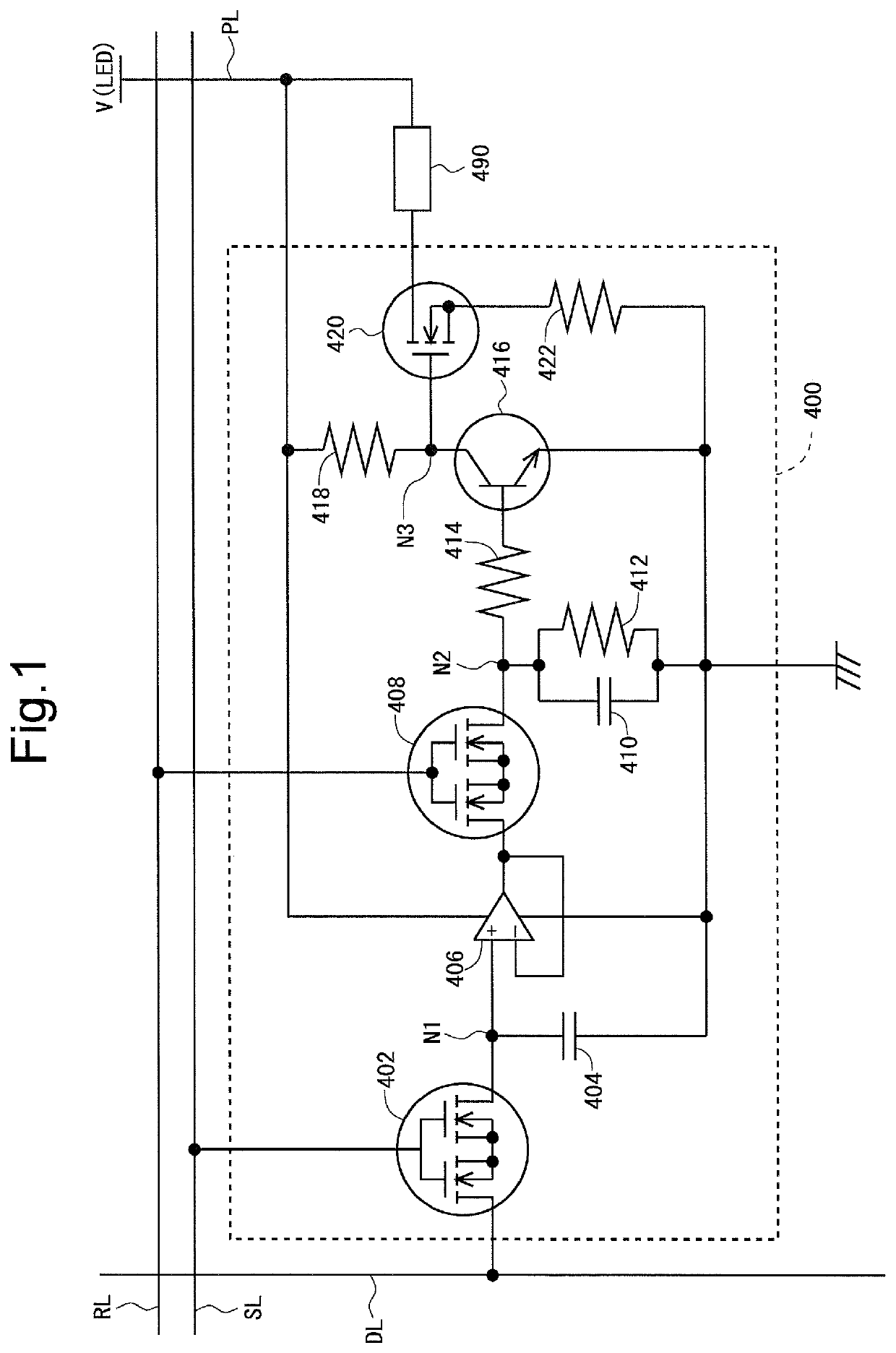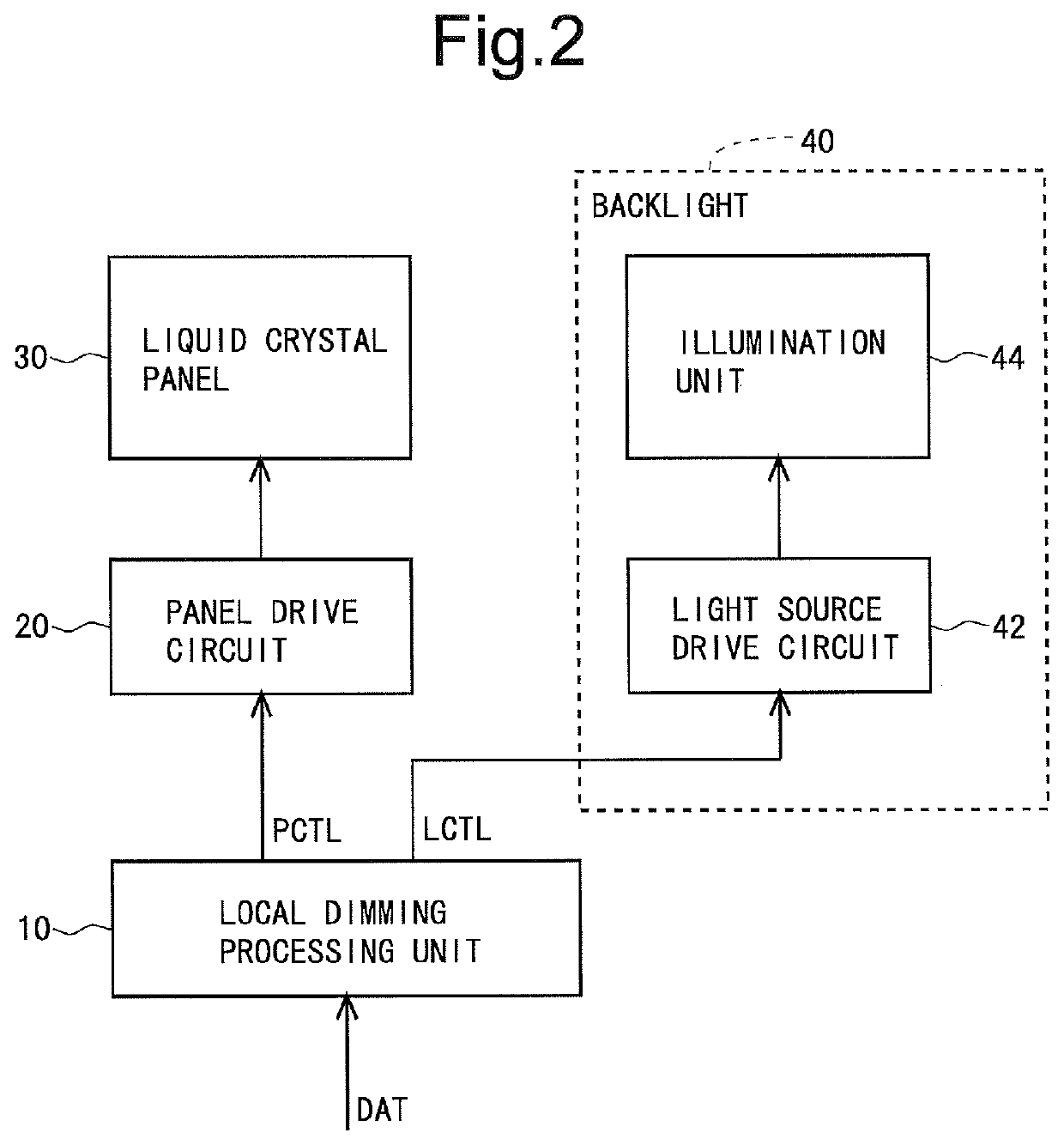Light emitting device, display device, and LED display device
a technology of led display device and light emitting device, which is applied in the direction of instruments, static indicating devices, etc., can solve the problems of chromaticity change depending on the current value, difficulty in implementing an approach to driving leds, and difficulty in performing control to obtain brightness with desired accuracy. , to achieve the effect of reducing the number of lines for driving leds, and reducing the occurrence of display defects
- Summary
- Abstract
- Description
- Claims
- Application Information
AI Technical Summary
Benefits of technology
Problems solved by technology
Method used
Image
Examples
first embodiment
[0120]FIG. 2 is a block diagram showing an entire configuration of a liquid crystal display device according to the first embodiment. The liquid crystal display device is constituted by a local dimming processing unit 10, a panel drive circuit 20, a liquid crystal panel 30, and a backlight (light emitting device) 40. The liquid crystal panel 30 is configured by two opposing glass substrates, and includes a display unit for displaying an image. The backlight 40 is provided on a back surface of the liquid crystal panel 30. The backlight 40 includes a light source drive circuit 42 and an illumination unit 44. The illumination unit 44 includes LED units (each of the LED units is constituted by one or more LEDs) and LED drive circuits which are mounted on a substrate (LED substrate) and will be described later. The local dimming processing unit 10, the panel drive circuit 20, and the light source drive circuit 42 are typically provided on different substrates.
[0121]A display unit 32 in t...
second embodiments
[0155]In a case in which microscopic LEDs such as mini LEDs and micro LEDs are employed for the light source of the backlight, a size of am area as a driving unit for local dimming becomes extremely small. In this case, regarding the LED substrate, it is often difficult to secure region for placing the components such as field-effect transistors (FETs) that constitute the LED drive circuit 400 described above. Therefore, as the second embodiment, an example in which the LED drive circuit 400 and lines such as the scanning lines SL and the like are stacked on the LED substrate will be described.
[0156]As a material of the LED substrate, glass or plastic may be employed. The LED drive circuit 400 and lines such as the scanning lines SL and the like are stacked on the LED substrate. On one surface facing the liquid crystal panel 30 out of surfaces of such a LED substrate, the LEDs are mounted by chip bonding.
[0157]It should be noted that an overall configuration and a schematic configur...
third embodiment
[0167]FIG. 9 is a block diagram showing an entire configuration of a LED display device according to the third embodiment. The LED display device is a display device using LEDs as pixels. As shown in FIG. 9, the LED display device is configured by a video signal processing unit 60, a light source drive circuit 62, and a display unit 64. It should be noted that the display unit 64 in this embodiment corresponds to the illumination unit 44 in the first embodiment (see FIG. 2). Specifically, the display unit 64 is constituted by the LED units and the LED drive circuits which are provided on the substrate (LED substrate). The video signal processing unit 60 and the light source drive circuit 62 are typically disposed on different substrates.
[0168]The video signal processing unit 60 receives the image data DAT transmitted from outside, and outputs the brightness control signal LCTL for controlling an operation of the light source drive circuit 62. Here, the brightness control signal LCTL...
PUM
| Property | Measurement | Unit |
|---|---|---|
| brightness | aaaaa | aaaaa |
| brightness | aaaaa | aaaaa |
| lighting frequency | aaaaa | aaaaa |
Abstract
Description
Claims
Application Information
 Login to View More
Login to View More - R&D
- Intellectual Property
- Life Sciences
- Materials
- Tech Scout
- Unparalleled Data Quality
- Higher Quality Content
- 60% Fewer Hallucinations
Browse by: Latest US Patents, China's latest patents, Technical Efficacy Thesaurus, Application Domain, Technology Topic, Popular Technical Reports.
© 2025 PatSnap. All rights reserved.Legal|Privacy policy|Modern Slavery Act Transparency Statement|Sitemap|About US| Contact US: help@patsnap.com



